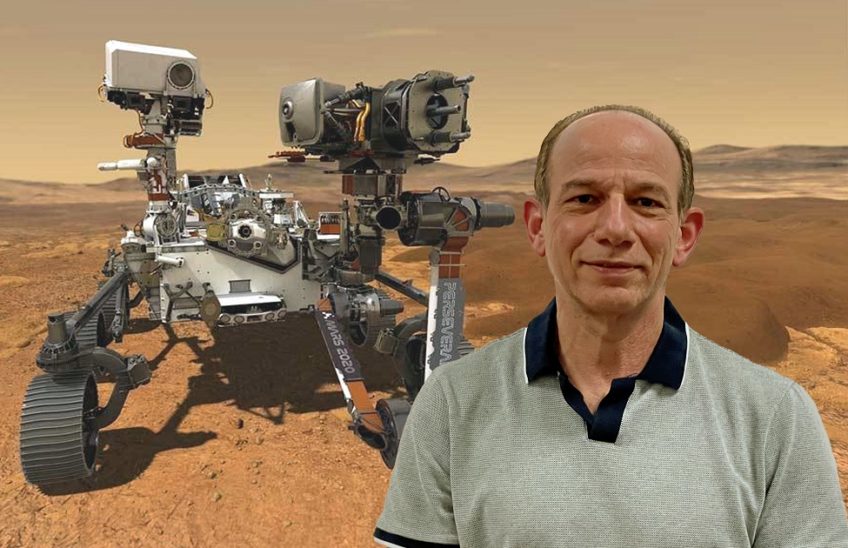The Mars 2020 Perseverance Rover is collecting samples in search of signs of ancient microbial life, which would advance NASA’s quest to explore the past habitability of Mars. The samples are set to return to Earth no earlier than 2031, as part of the Mars Sample Return campaign being planned by NASA and the European Space Agency. Before the rover went to space, NASA and its engineers worked hard to prevent Earth’s microbes from contaminating Mars. Now, before the samples collected by the rover return to Earth, Florida Atlantic University is helping NASA design protocols for sterilizing Mars material and protecting our biosphere.
Gregg Fields, Ph.D., executive director of FAU’s Institute for Human Health and Disease Intervention (I-HEALTH) and a professor in the Department of Chemistry and Biochemistry in the Charles E. Schmidt College of Science, is working in collaboration with a team of scientists to ensure a “microbe-free” return of Mars samples in a vessel with multiple layers of protection. The sample container would be launched into Mars orbit, collected by a spacecraft that would package it inside a sealed container, sterilize the seal, and then package that container inside another sealed vessel.
Fields, a leading expert in chemistry and biochemistry, was invited to work on the heat sterilization step with researchers from the NASA Jet Propulsion Laboratory based out of California, Nelson Laboratories headquartered in Utah, and Johnson & Johnson based in New Jersey. The research group has been addressing not only heat-resistant bacteria, but individual proteins that, on Earth, can act as infectious agents (e.g. Bovine Spongiform Encephalopathy or Mad Cow Disease). These biomolecules were chosen for testing as representatives of the simplest, hardiest infectious agents known. Fields is providing complimentary technologies for assessing degradation of the protein-based targets from his laboratory on FAU’s John D. MacArthur Campus at Jupiter.
“Our plan is to ensure that when the samples return to Earth, potentially hazardous material from the Mars rover is either fully contained or sterilized,” said Fields. “In addition, it’s imperative for the samples obtained by the rover to be contained within an ultra-clean environment when it returns to Earth. That way, scientists will know that any potential discovery of ancient life did in fact originate on the red planet.”
The car-sized rover landed in the Jerezo Crater, a 28-mile-wide basin located on the planet’s northern hemisphere. Experts believe that around 3.5 billion years ago, a river flowed into a body of water about the size of Lake Tahoe, which straddles the border of California and Nevada. According to NASA, this is one of the best places to search for signs of microbial life, as the ancient river could have collected and preserved organic molecules.
While the rover explores, it will be collecting samples of rocky material – up to 30 of which may be returned. The M2020 rover is equipped with seven instruments, 25 cameras — the most ever in deep-space exploration — and even a helicopter the size of a tissue box to take aerial images. The rover uses a rotary-percussive drill and hollow coring bit to drill into rocks and collect samples just a little thicker than a pencil. This sampling system is located on the end of the rover’s 7-foot-long robotic arm. These state-of-the-art tools are collecting information about Martian geology, environmental conditions, atmosphere and possible biosignatures that can be used as evidence for past or present life.
“Most proteins we think about are obviously very helpful in our bodies. However, there are very specific proteins that have been noted to behave in a pathological fashion that contribute to disease, for example, Alzheimer’s and Parkinson’s diseases,” said Fields.
The overarching plan would be to inactivate or encapsulate any potentially hazardous bioactive particles by heating and sealing the sample tubes inside multilayered vessel that will return to Earth. However, the ideal temperature and duration to get the job done is still being determined. To figure this out, the partner laboratories send Fields heat-treated samples of a common protein called bovine serum albumin as well as model prion protein.
The team is targeting near-total disassembly of the protein – more than enough to render it inactive. Fields’ laboratory uses a combination of analytical techniques, such as mass spectrometry and liquid chromatography, to look at how much of the protein sample has broken down. So far, he has tested the protein treated at 350- and 450-degrees Celsius (662- and 842-degrees Fahrenheit).
“We tested the bovine serum albumin at 350 degrees, which does a pretty good job of breaking down the protein, but it doesn’t break it up all the way,” said Fields. “Higher temperatures of 400 or 500 degrees are likely better to break the proteins down into the amino acid components, which are the building blocks of proteins.”
Because the samples will not return to Earth no earlier than 2031, Fields has time to continue experimenting in his laboratory.
“I don’t think that there are any dangerous microorganisms and proteins on Mars, but we still have to prepare and protect against it,” said Fields.
-FAU-



